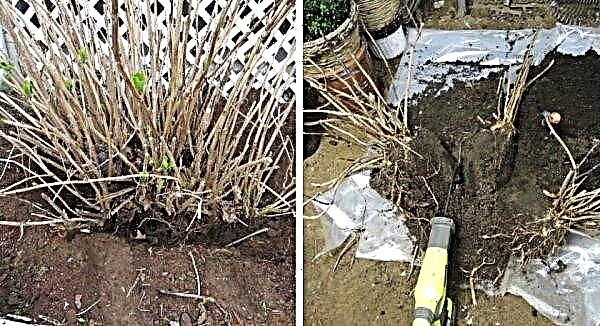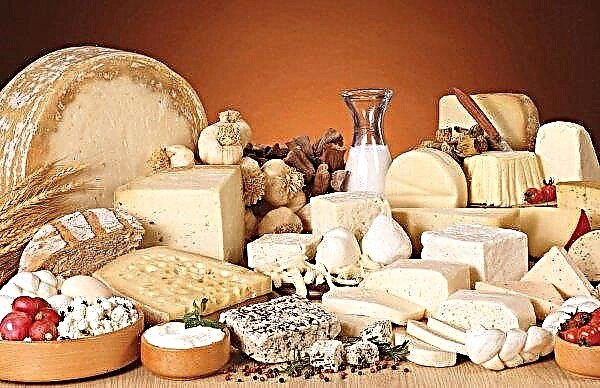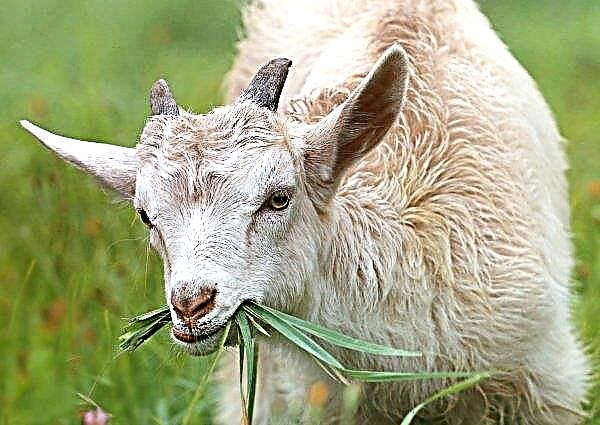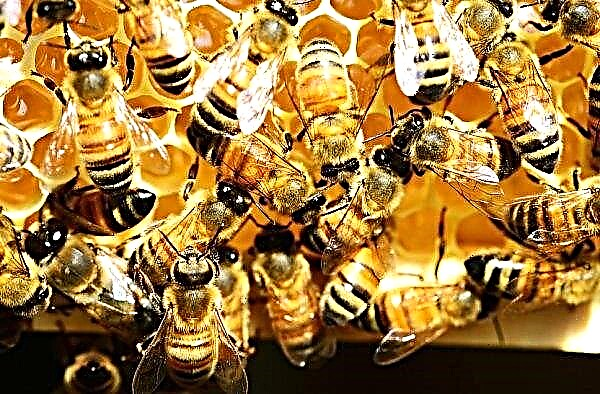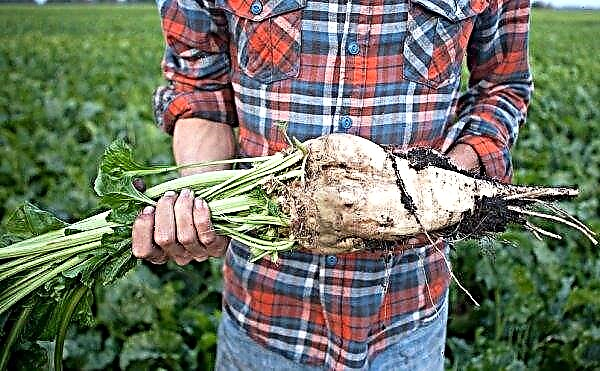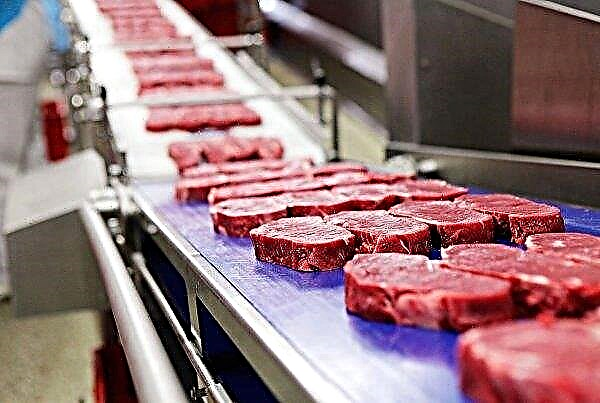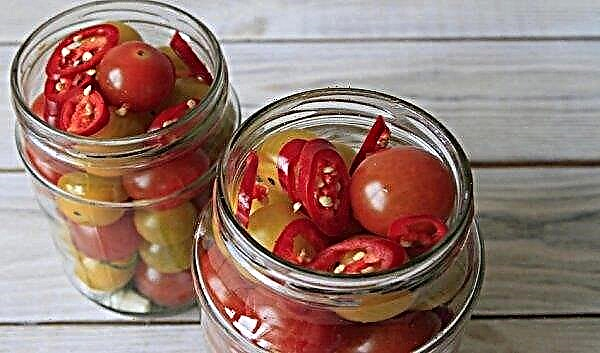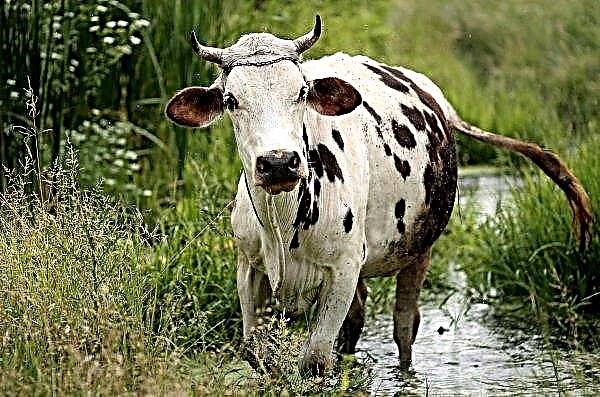Among the autumn varieties that are suitable for cultivation in the northern regions, I would like to note the Uralets apple tree. It is characterized by high frost resistance, resistance to major stone diseases. Read about the features of the variety and cultivation technology in this review.
Origin history
Uralets is the oldest variety of the Sverdlovsk experimental station. It was bred more than 40 years ago under the guidance of breeder P. Dibrov. Obtained by repeated crossing. For this, Anise pink striped, Ukrainka Saratovskaya and several oriental varieties of apple trees were selected. The aim of the selection was to improve existing varieties.
Did you know? In the world there are more than 8,000 varieties of apples. And this is the largest variety of fruit trees.
The resulting tree is characterized by a slender pyramidal crown, strong growth and excellent adaptability to weather conditions in different regions. It is zoned under the Volga-Vyatka district. At the moment, it is distributed not only in the central regions of Russia, but also in Siberia, the Urals, Kazakhstan and other CIS territories.
Description and characteristics of the variety
This is a wonderful early autumn variety with good taste. Tasting assessment of apples - 4.2 points out of 5. Apple tree blooms in mid-May, and its fruits ripen by early September. Like other summer apples, they are not stored for long - no more than 1-1.5 months. The variety is universal, apples are consumed fresh, harvested in the form of juices, drinks, jams and other dishes.
Check out these autumn apple varieties:
Tree
Uralts apple trees tall. Their height exceeds 3-4 m, so they need the formation of a crown. They are characterized by vigorous growth and durability. Branches grow at an angle of 90 degrees to the trunk, so the crown acquires a certain roundness.
The tree is considered resistant to scab, as well as frost-resistant. It grows well on most soils and in different climatic zones. The variety is self-fertile. Therefore, a pollinator tree is necessarily planted nearby. The best pollinator is considered the Ural bulk.
Fruit
The apple tree bears fruit on simple and complex gloves. Fruits on the branches are evenly spaced. Most ovaries are formed on the growth of the previous vegetative period. Fruiting occurs 4 years after planting. It is characterized by stability.
Characteristics of fruits of the Uralets variety:
- apples: round, small, uniform, weighing 60–70 g;
- skin tone: in technical maturity - green, in ripened form - creamy pink with a striped blush;
- peel: thin;
- pulp texture: juicy, delicate, dense, cream color;
- taste: sweet and sour, slightly tart and astringent;
- tasting characteristic: 4.2 points;
- productivity: 70–80 kg are harvested annually from one apple tree;
- fruit keeping quality is low, fruits are stored up to 1.5 months.
Did you know? Until 1600, all fruits that were not berries were called "apples." That is why many people think that Eve ate an apple, although the Bible does not indicate that the fruit was an apple.
Preliminary preparation before landing
In order for the apple trees to be tall, healthy and productive, they need a little more care than just digging a hole and planting them. Therefore, it is worthwhile to rationally approach the choice of the site.
It should be:
- brightly lit by the sun for 6-7 hours a day;
- well drained;
- fertile.
Dense soils are diluted with sand for ease, while sandy soils are supplemented with clay. If there are stones or debris on the site, they should be removed during planting. To improve the development of the apple tree, fertilizers are introduced into the planting pit.
How to choose the right seedlings
If you are ready to plant, then start by soaking the roots of the seedling in water for 2–4 hours. This is necessary, as seedlings from nurseries come with "empty" roots. To facilitate the collection of moisture from the soil, the roots are soaked. Then they are dipped in clay mash with the addition of copper sulfate. This will prevent its contact with soil pathogens.
Important! If the landing is autumn — do not fertilize. By this you can provoke the growth of branches, which means that the tree does not have time to prepare for the winter and die.
Please note that the correct seedling must be characterized by:
- age: 2 years;
- straight trunk;
- height: 0.7–1 m;
- number of side branches: from 5 and more;
- lack of damage, defects and deformations;
- unblown kidneys;
- fresh, bright bark;
- developed root system;
- lack of damaged and rotting roots.
 When buying a seedling in a nursery, there will be a tag on it indicating the variety and age. You can also request other information about the variety: fruiting period, resistance to diseases and pests, regionalization.
When buying a seedling in a nursery, there will be a tag on it indicating the variety and age. You can also request other information about the variety: fruiting period, resistance to diseases and pests, regionalization.Site selection
Basic requirements for the site:
- on a flat area, the tree must be placed so that it is covered from the north winds;
- on a hilly plot elevation is selected; it is recommended to avoid lowlands in which cold air can accumulate;
- if you imagine that the tree has reached its maximum size, then power lines and other obstacles should not pass over it;
- near the roots there should not be highways, water pipes and other objects that could be damaged by them.
Good drainage is mandatory, as the roots cannot absorb nutrients from the swampy soil. As a result, they will begin to hurt and the tree may die. It is not recommended to plant trees on stony soils. Digging the site before planting is a very important process!
Digging the site before planting is a very important process!
Step-by-step landing process
Plant apple trees at a distance of 3-4 m from each other and 5-6 m between rows if you are creating a garden. Remember, they should not obscure each other and interfere with growth. This will reduce yield and increase the likelihood of pest damage.
Did you know? Apples will help maintain a healthy complexion and flawless skin. Vinegar, which is contained in the fruit, reduces oily skin, eliminating inflammation, acne, acne.
Landing technology:
- Soak the roots of the seedling for several hours before planting, and then dip them in a clay mash with copper sulfate.
- Dig a landing hole; size 0.7 × 0.7 m.
- Mix the removed soil with a bucket of humus.
- Add 100 g of potassium phosphate fertilizers.
- Lay the soil mixture at the bottom of the pit.
- Place the seedling in the center of the hole.
- Flatten the roots.
- Fill the hole, starting from the sides.
- Compact the soil to prevent air pockets.
- Make sure that the junction of the scion and the stock is above ground.
- Water the tree with 2 buckets of water.
 Proper planting of apple trees: 1 - laying a seedling in a trench; 2 - a seedling dug for the winter. Watering will also be necessary 2-3 times a week during the first months after planting. This will improve the conditions for rooting the tree. If the soil dries quickly, then on top it can be covered with a layer of mulch to preserve moisture.
Proper planting of apple trees: 1 - laying a seedling in a trench; 2 - a seedling dug for the winter. Watering will also be necessary 2-3 times a week during the first months after planting. This will improve the conditions for rooting the tree. If the soil dries quickly, then on top it can be covered with a layer of mulch to preserve moisture.Features of seasonal care
Variety Uralets refers to a very unpretentious in the care and cultivation. It does not require special conditions, but the gardener needs to carry out basic agricultural activities, as for other varieties.
Agrotechnics for apple care includes:
- watering;
- loosening the soil and removing weeds;
- fertilizer application;
- periodic cropping;
- harvesting;
- preparing an apple tree for winter.
Soil care
Soil care includes weed removal, cultivation and mulching. Weeds grow well in all areas. They are dangerous for a young tree in that they take away nutrients and moisture from it. They are removed manually or using garden tools. It is advisable to do this a few hours after watering. From soft soil they will be removed quickly and without leaving roots. If you do not like to loosen the soil and remove weeds - cover the trunk area with sawdust, wood chips, straw or other covering material. It will prevent weed growth, protect the soil from pests, prevent soil compaction at the roots and maintain optimal moisture. The layer of mulch should be at least 6 cm. In autumn, it is removed along with the fallen leaves and replaced with a new one. It will serve as an insulating coating and will protect the roots from freezing along with the soil.
It will prevent weed growth, protect the soil from pests, prevent soil compaction at the roots and maintain optimal moisture. The layer of mulch should be at least 6 cm. In autumn, it is removed along with the fallen leaves and replaced with a new one. It will serve as an insulating coating and will protect the roots from freezing along with the soil.
Did you know? If you want to try at least one apple a day, from the world's 8,000 varieties, you will need at least 20 years to complete the tasting.
Feeding and watering
If there is no rain, young trees are watered once a week. They are enough for 2 buckets of water. An adult tree has a fairly extensive root system and is not so dependent on watering. Such a tree is enough 1-2 waterings per month. If possible, apply drip irrigation. So the water will go directly to the roots with a small pressure, which will ensure good soaking of the root zone, and not just the surrounding soil. A healthy apple tree gives an increase of 30-60 cm during the growing season. Therefore, before applying fertilizer, take a ruler or tape measure and measure the growth of the previous year. Drop watering of apple trees. If you doubt whether to fertilize, then apply half the dose. All fertilizers for the garden should contain nitrogen, phosphorus and potassium. If 9-3-0 is indicated on the package with fertilizers, this means that it contains 9% nitrogen, 3% phosphorus and no potassium. Nitrogen helps the growth of the green part of the plant. Phosphorus promotes root development and flowering. Potassium is involved in fruiting and seed development. Spring fertilizer should ensure the growth and fruiting of apple trees.
Drop watering of apple trees. If you doubt whether to fertilize, then apply half the dose. All fertilizers for the garden should contain nitrogen, phosphorus and potassium. If 9-3-0 is indicated on the package with fertilizers, this means that it contains 9% nitrogen, 3% phosphorus and no potassium. Nitrogen helps the growth of the green part of the plant. Phosphorus promotes root development and flowering. Potassium is involved in fruiting and seed development. Spring fertilizer should ensure the growth and fruiting of apple trees.
The root system of the tree is activated and begins to actively absorb nutrients and water. It is recommended to add ammonium nitrate - 40 g or 600 g of urea as sources of nitrogen to enhance vegetation. From April to June, after the apple trees bloom, the tree spends its energy on the growth of fruits. In summer, 70 g of potassium sulfate or other potash fertilizers are added. Then they feed with superphosphate 40 g or other phosphorus fertilizer.
Preventative treatment
An apple tree that grows in the “right conditions” will most likely not have problems with pests or diseases. The variety is resistant to fungal infections, including scab. A quality pest and disease control begins with the simplest measures.
It is necessary:
- maintain weed-free space around the apple trees;
- remove fallen leaves and other organic residues that may serve as a home or wintering place for pests and fungal spores;
- dig the soil;
- prune dry branches;
- brush the lichens that settle on the branches of old apple trees;
- spray trees with copper-based solutions several times per season: on a bare tree, during the opening of buds and before flowering; these include copper sulfate and Bordeaux liquid;
- remove the branches damaged by the disease, treat the cut site with copper sulfate and paint with oil paint to prevent fungi from getting inside.
To control pests, farmers use insect traps. These are containers that inside contain a sticky coating with pheromones. Moths adhere once inside. In order for the trap to be most effective, it is placed on the outside of the tree, so that there are fruits nearby.
Important! When the trees enter the fruit ripening phase, they do not spray them so that the toxins do not enter the human body.
The trap should not overlap the leaves. It should be easily accessible to moths. The rate of trap placement is 1 per 100 apples. Tall trees will need about 8–10 such traps. Pheromone traps are an effective means of pest control.
Pheromone traps are an effective means of pest control.
Cropping and shaping the crown
Trim in winter while the tree is at rest. Do not cut them in the summer, as infections are likely to get into the tissue of the tree through the places of cuts. For apple trees, it is recommended that crown formation be made in the shape of a vase. To do this, shorten the central trunk. This stimulates the development of side shoots. 4 such shoots rising upward at an angle of 45 degrees to the trunk create a cup-shaped structure - a “vase”. When the crown is formed, in the future only shortening of the individual branches is required.
Did you know? In some countries, a thin layer of wax is applied to the collected apples. And it is not at all for beauty, but in order to prevent bacteria from entering the surface of the fruit and slow down their ripening.
In the process of winter pruning, you must:
- remove all broken, dry or diseased branches;
- remove branches that duplicate other branches and create a thickening;
- prune any branches that are too tilted to the ground;
- check that all branches receive uniform illumination and flow around the air.
Video: winter pruning of the apple tree
Cold protection
The most vulnerable part of the tree is the roots. They can freeze with the ground. As a result, the tree will underdevelop next year. To prevent this, the root zone in autumn is covered with a thick layer of mulch. It can serve as an insulating layer, increasing the temperature of the soil under the layer.
The next most vulnerable object is branches and trunks. The trunk can overheat in bright sunlight. Having gained a lot of heat, he does not have time to give it before the cold night. This leads to cracking. To prevent cracking, the trunk is whitened in the fall. White color repels the sun's rays and does not allow the trunk to overheat.
Ice is a particular danger for fruit buds. In late autumn, raining may freeze on the branches with an ice crust. It will damage the fruit buds and cause a lack of harvest. Unfortunately, such situations cannot be completely prevented.
Harvesting and storage
Apples ripen in September. The basic ripeness criterion is the acquisition by apples of the color that is basic for this variety. You can also try to remove the fruit from the branch. If it is easily separated, then you can harvest. Harvesting is carried out in dry sunny weather. Sort the collected apples. First set aside separately damaged, hit, or deformed fruits.
Then size the apples. Stack fruits of the same size in one box. Leave enough space between them, as apples continue to grow even when stored. Transfer apples with straw or paper to prevent fruit rubbing against each other.
Important! It is forbidden to pull the fruit by force. You can tear the apple along with the fruit buds of the future harvest.
Harvest Uraltsa can be stored for no more than 1-1.5 months. Therefore, if you have many different varieties, then mark on the boxes the dates by which you need to eat or process apples. Boxes with fruits can be stored in a room with an air temperature of about 0 ° C and a humidity of 70–80%. A small amount of fruit can be packed in a plastic bag in the refrigerator. Caring for the Uralets variety is quite simple. In addition, the tree is resistant to fungal diseases. Therefore, you can always try to grow it on your site. But only if there is enough space for planting two apple trees: the Ural and its pollinator.
Caring for the Uralets variety is quite simple. In addition, the tree is resistant to fungal diseases. Therefore, you can always try to grow it on your site. But only if there is enough space for planting two apple trees: the Ural and its pollinator.




